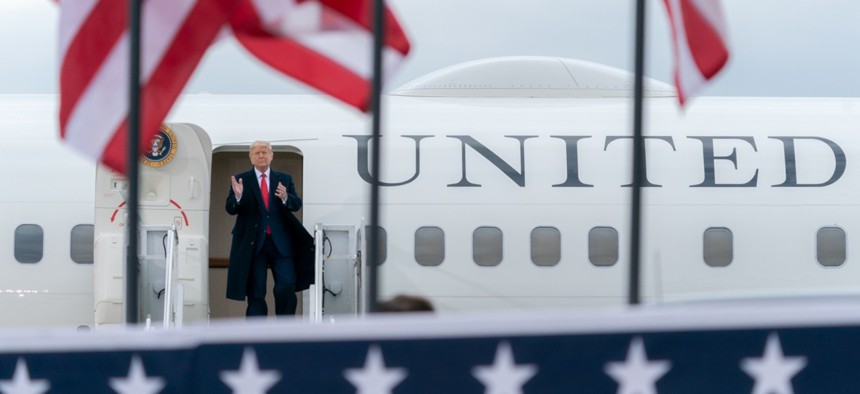
Official White House Photo by Shealah Craighead
Viewpoint: When an Executive Order Is Racist
President Trump’s directive on diversity training undermines the 1964 Civil Rights Act.
In 1965, President Lyndon Johnson signed legislation requiring that federal contractors offer equal employment opportunities and prohibit discriminatory practices. Following on the heels of the landmark 1964 Civil Rights Act, the new statute sought to make clear that the federal government, and by extension its contractors, was committed to leading the movement toward equality and equity in America.
This week, 55 years later, the Office of Federal Procurement Policy will be accepting public comments on the implementation of President Trump’s Sept. 22 executive order on diversity and inclusion training. Under normal circumstances for a routine rulemaking, this would be just another step in the usual regulatory process. But circumstances are anything but usual and this is no routine executive order. Trump’s directive represents a stark threat to the commitments made by this nation in 1965.
The executive order would prohibit government contractors—all tens of thousands of them representing an estimated 20% of the U.S. workforce—from doing internal training within their own companies that includes the teaching or exploration of concepts like systemic racism and white privilege. Companies that violate the order would be subject to a range of penalties, including contract termination and even debarment. This order follows one of similar form and substance prohibiting such programs in federal agencies and the military.
The comments submitted on Oct. 21 will almost certainly cite the unprecedented intrusion of the federal government on internal, private company practices. Some will point out that the order places companies in the untenable position of pitting their values against their (and their employees’) economic interests, even survival. They will attempt to explain that the increasingly diverse American workforce offers great opportunity, but also requires thoughtful strategies for building organizational cohesion. The concepts of race and privilege must be openly explored. The comments will also include questions about the challenges of compliance with the order and the potentially extreme penalties. And they will question why the administration has already opened a hotline for employee complaints even before the implementing rules have been written. I would add one more point. At its heart and as the term is understood and defined today, the executive order is racist.
To reiterate: “as the term is understood and defined today.” How is it possible to address issues of race and equality in America without having open, even difficult conversations about the very concepts and terms the order prohibits and enabling those conversations to take place in a contemporary context? Indeed, the terminology may be old but the way the issues are thought about and discussed today is new. Is America a “racist” country? Is there systemic racism? Is white privilege real? There are, of course, scores of experts qualified to discuss these issues. But in their contemporary context, the basics are actually not very complicated.
Start with white privilege. As Washington Post columnist Christine Emba wrote, white privilege is “the level of societal advantage that comes with being seen as the norm in America, automatically conferred irrespective of wealth, gender or other factors. It makes life smoother, but it’s something you would barely notice unless it were suddenly taken away—or unless it had never applied to you in the first place.” That doesn’t mean individuals, regardless of color, haven’t worked damn hard to get where they are. In its most basic sense it means that if you, like me, were born white, you have certain innate and structural privileges. Can anyone reasonably disagree with that?
By that same logic, a society in which white privilege exists, is a society in which there is systemic racism. After all, “racist” and “racism” don’t just describe the evil acts of the likes of Sherrif Bull Connor or the Boogaloo Boys. As Robin DeAngelo, author of “White Fragility” explains, “Racism is not simply the utterance of racial slurs or acts of racially motivated violence—behaviors, in other words, that are performed by individuals.” Simply put, whether it is a root cause or offshoot of white privilege (or, in a unique way, both), it can be conscious or unconscious, structural or unintended. That’s why efforts to eliminate implicit bias in hiring and promotion are so important and have become so ubiquitous. It is also why we have socio-economic goals in federal contracting.
There are, to be sure, many complex layers to these issues. And we can, indeed must, openly discuss, debate and come to grips with what it all means and how to address it. It is neither easy nor comfortable. But leaders and organizations lead by example. As the law Lyndon Johnson signed more than a half century ago made clear, when it comes to working toward the American ideal, the government needs to lead the way. Prohibiting fulsome teaching and discussion across the full spectrum of issues associated with race and racism in the country today is exactly the opposite. It is regressive. It has real economic and societal implications. It is likely unconstitutional. And it is racist.






